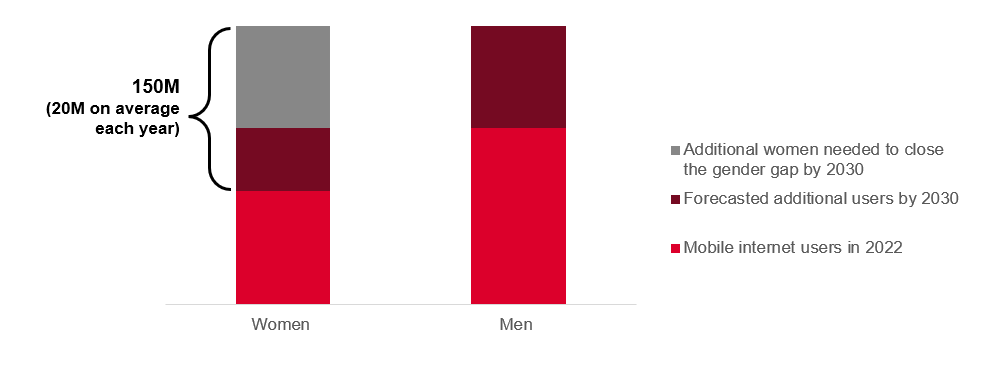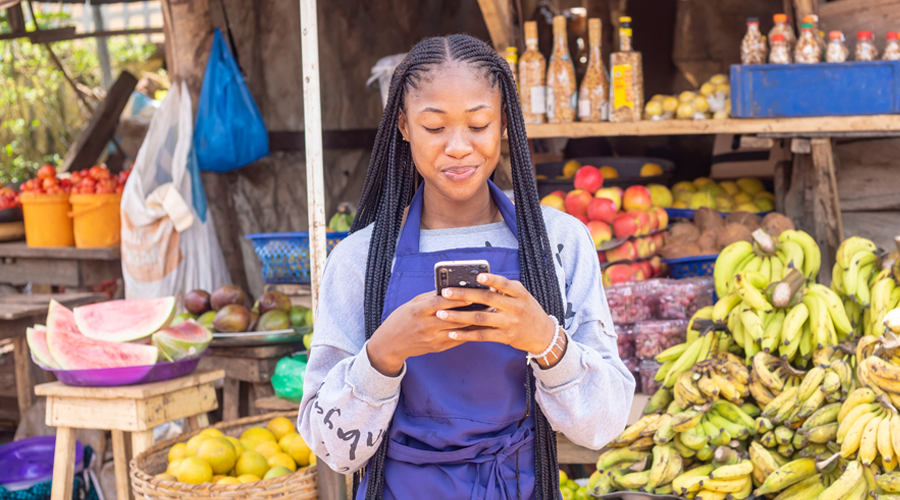Cliquez ici pour lire ce blog en français.
In Sub-Saharan Africa, mobile phones are reshaping the region in unprecedented ways. They have transcended their initial purpose of communication to become catalysts for progress in various areas, including healthcare, education, finance and agriculture, offering innovative solutions that drive social and economic development. However, access is not equal. By the end of 2022, 69% of the female adult population in Sub-Saharan Africa (220 million women) owned a mobile phone, and 32% were using mobile internet (100 million women); a significant increase from previous years.
Whilst these figures indicate more women in the region are using mobile internet than ever before, a staggering 215 million women were still not using it by the end of 2022. The Mobile Gender Gap Report 2023 indicated that women in Sub-Saharan Africa were 36% less likely than men to adopt mobile internet, a gender gap that has changed little since 2017. Based on this data, it was estimated that over 150 million additional women in Sub-Saharan Africa would need to come online to close the mobile internet gender gap in the region by 2030 (Figure 1), highlighting the need to focus attention on this stubborn and significant divide.
Figure 1: Mobile internet users across Sub-Saharan Africa in 2030 (millions)

Why is closing the mobile gender gap in Sub-Saharan Africa important?
A significant economic opportunity exists in closing the mobile gender gap in Sub-Saharan Africa. GSMA research estimates that closing this gap in access and use by 2030 would contribute $60 billion in additional revenue for the mobile industry in the region.
The Mobile Economy Sub-Saharan Africa 2023 Report also reveals that mobile technologies and services contribute to over 8% of the region’s GDP, adding $170 billion in economic value.
Connecting all women to mobile internet will bring significant benefits to individual women and their families, the economy and businesses, while at the same time contributing to the achievement of the African Union’s Agenda 2063 and the UN Sustainable Development Goals.
Increased mobile internet adoption is transforming lives and is associated with higher levels of well-being. Mobile phones help empower women, making them feel more connected, autonomous and safer, and providing access to information, services and life-enhancing opportunities. This includes access to important information that helps them in their daily lives and that they would not have received otherwise. Mobile also has the potential to contribute positively to protecting women’s human rights and to strengthen their economic, social and political empowerment and development. In fact, between 65% and 82% of women who use mobile internet in five surveyed countries in the region reported that it positively impacts their lives.

Closing the mobile gender gap by 2030
The Mobile Gender Gap Report 2023 outlines the top barriers to be addressed in survey countries across Sub-Saharan Africa, which include affordability (specifically of internet-enabled handsets), literacy and digital skills as well as lack of perceived relevance. These represent a substantial growth opportunity for the mobile industry and inform the priorities of all stakeholders.
Mobile operators, governments, the development community and other stakeholders must work together to address the mobile gender gap
The Mobile Gender Gap Report 2023 emphasises the importance of improving the quality and availability of gender-disaggregated data, understanding women’s needs and the barriers they face to mobile ownership and use, and addressing these needs through focused gendered interventions and policies. One key recommendation is for partnerships and collaboration between mobile operators, governments, the development community and other types of stakeholders.
Through the Connected Women Commitment Initiative, over 20 mobile operators in Sub-Saharan Africa have made formal commitments since 2016 to increase the proportion of women in their mobile internet or mobile money customer base. Their efforts to drive the digital and financial inclusion of women include offering low-cost internet-enabled handsets to address women’s price sensitivity, savings and loan products aimed at women, and improving women’s digital literacy through educational programmes, among others.
Mobile phones and the internet can unlock the potential of millions of women, drive social and economic progress, innovation and prosperity across Sub-Saharan Africa
The journey towards closing the mobile gender gap in Sub-Saharan Africa presents a significant social and economic opportunity that can propel the region forward, with women as a driving force of change and sustainable transformation. The progress made in recent years is commendable, but the road ahead requires sustained and collaborative efforts to ensure women are no longer left behind.
Stay tuned for updated data and insights on women’s mobile internet access and use in our upcoming Mobile Gender Gap Report 2024.
The Connected Women programme is funded by the UK Foreign, Commonwealth & Development Office (FCDO) and the Swedish International Development Cooperation Agency (SIDA), and is supported by the GSMA and its members.



